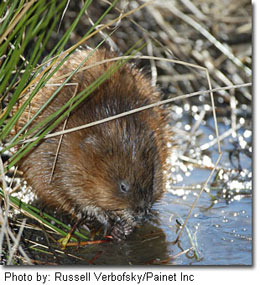Common Muskrat
(Ondatra zibethicus)
 Description & Range:
Description & Range:
Muskrats are the only species in the genus Ondatra. They are medium-sized
rodents that are covered in waterproof, brown fur and have a thin, rudder-like
tail covered in scales. The hind feet of muskrats are large and webbed to aid in
swimming. Muskrats are 16 to 24 inches long and weigh up to 4 pounds. Muskrats
are named after the musky odor produced by their scent glands.
Muskrats are common throughout Maryland and the rest of the United States,
except for particularly dry regions.
Habitat:
Muskrats live in both brackish and freshwater lakes, ponds, streams, rivers,
swamps and marshes throughout much of North America.
Diet:
Muskrats primarily eat aquatic plants, including cattails, sedges, water lilies, arrowheads and duckweeds. In some areas, muskrats will feast on mats of algae.
Occasionally, when food is scarce, muskrats will consume other animals such as
crayfish, snails, mussels, frogs, insects and fish. Muskrats often construct
feeding platforms in the marsh to sit and eat food they have collected.
![Muskrat_Lodge_KWixted[1].jpg](/wildlife/PublishingImages/Muskrat_Lodge_KWixted[1].jpg)
Reproduction:
Muskrats can breed year round, but most breed in March-May. After breeding,
gestation lasts about a month, and a litter of 5-10 young are born. The young
are born blind and have little hair. By two weeks of age, the pups will be fully
furred and will have open eyes. By six weeks of age, the pups are fully
independent, and the female usually has another litter on the way. A female can
have up to 5 litters of young per year.
Behavior:
Muskrats are active throughout the day and night. These semi-aquatic rodents
spend much of their time in and around water. Muskrats build dens in river banks
or construct lodges similar to beavers. Both dens and lodges consist of
underwater tunnels and dry chambers. During the winter, muskrats spend the
majority of their time in their dens. Sometimes, if the den or lodge is not warm
enough, then the muskrat will have to relocate.
Management:
Muskrats are managed as fur-bearing animals, so annual hunting and trapping
seasons for muskrats have been established in Maryland. Click here for more information on
furbearer management.